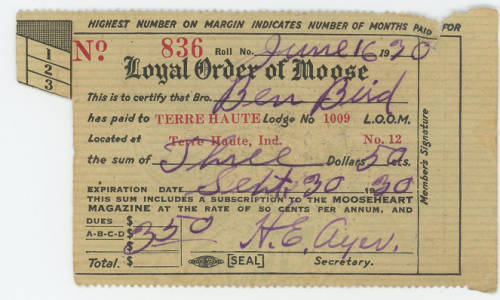EPHEMERA
A Definition
| objects that, when they were produced, were not intended to last a long time |
| objects specially produced for one occasion | something temporary |
We are often asked what difference it makes if a closed or defunct lodge or clubs minutes, records, proceedings, newsletters, and regalia end up in the trash. Who cares? What difference does it make? No one wants to read that old stuff anyhow.
Rare and one of a kind items are being thrown away, or sold at auction, or offered online just to make a buck. Books are being discarded. Libraries are going digital. Buildings are sold for new uses as less people are involved in clubs and groups. One reason to preserve the physical objects is that it is the authentic and original version and it can be used for research in the future. These objects can provide evidence of history, and help to interpret past events. Follow along to learn more.
Artwork

Artwork and Murals
Preserving art and murals is an important part of protecting the history and culture of fraternal organizations. These pieces, whether painted directly on lodge walls or created as banners and canvases, are full of symbols that speak to the values, rituals, and identity of the groups that used them. Many are fragile now because of age, light damage, or changing environments. Taking care of them means documenting what we have, keeping them in stable conditions, and sometimes working with professional conservators or creating digital versions. When we do this work, we’re making sure these meaningful and often beautiful pieces of history last for the future. Image: Gustave Brand artwork at Allentown Masonic Lodge.
Regalia and Costumes

Fraternal organizations costumes—whether ceremonial robes, sashes, or other regalia—are some of the most vivid links to their past. These outfits not only reflect the values and rituals of the organizations but also serve as tangible artifacts that tell stories of fellowship, tradition, and community. Preserving these garments ensures they remain part of that legacy for future generations.
Understand the Material
The first step in preserving fraternal costumes is to understand the fabrics and materials they are made from. Many of these garments are crafted from delicate textiles such as silk, satin, velvet, or wool, which require specific care.
Key points:
- Silk and satin are particularly fragile and prone to fading and tearing.
- Velvet can lose its pile or become crushed if not handled properly.
- Wool may attract pests like moths if not stored carefully.
- Embellishments like embroidery, metallic thread, or beadwork need special attention to prevent corrosion or unraveling.
Before proceeding with any preservation, it’s important to document the materials and their condition.
Dues Cards

Historical Significance of Fraternal Dues Cards
Fraternal dues cards hold a rich historical significance within an organization’s culture, serving as a tangible link to the past and a symbol of membership continuity. These cards have been used for decades, often reflecting the unique traditions and values of the fraternity to which they belong. As artifacts, they encapsulate not only the identity of the organization but also the personal journeys of the members. The design and materials of these cards can vary widely, showcasing the evolution of an organization’s branding and the changing aesthetics over time, making them valuable pieces of history for both current members, scholars and even alumni.
Minute Books

Lodge manuscripts or minute books are important to preserve. Why?
They provide a record of a lodge’s activities, decisions, and membership over time. Lodges ensure the preservation of their heritage and traditions for future generations, allowing them to understand and appreciate the legacy of the organization. Minute books can also serve as a legal document. They record official proceedings, decisions and transactions, which can be crucial for governance. Studying past minutes can offer educational opportunities for members or researchers to learn about the lodge’s history, values, and practices.
Photographs
Why preserve old photos?

Photos provide a visual record of personal and cultural history, capturing unique moments, events, and people. They offer insights into the past, preserving memories that might otherwise fade over time.
Archival Preservation: Ensure Secure Storage
To safeguard photograph items, place them in a clean storage space with consistent temperature and humidity levels. [Aim for 68 degrees Fahrenheit or lower and maintain a relative humidity between 30-40%.] Lower temperatures are ideal for preserving color photos. High humidity and temperature accelerate deterioration, while low humidity can cause photos to crack, peel, or curl. Ensure proper air circulation, regularly inspect for pest activity, and avoid storing items in attics or basements. Opt for an air-conditioned room or closet for storage. Avoid exposing photographs to fumes, plywood, cleaning products, or cardboard.

